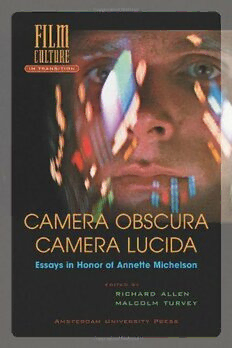
Camera obscura, camera lucida : essays in honor of Annette Michelson PDF
Preview Camera obscura, camera lucida : essays in honor of Annette Michelson
FFIILLMM FFIILLMM Annette Michelson’s contribution to art and film criticism over the last three decades has been un- paralleled. This volume honors Michelson’s unique C legacy with original essays by some of the many film A CCUULLTTUURREE M CCUULLTTUURREE scholars influenced by her work. Some continue her E efforts to develop historical and theoretical frame- R A works for understanding modernist art, while others IN TRANSITION IN TRANSITION O practice her form of interdisciplinary scholarship in B relation to avant-garde and modernist film. The intro- S C duction investigates and evaluates Michelson’s work U itself. All in some way pay homage to her extraordi- R A nary contribution and demonstrate its continued cen- , trality to the field of art and film criticism. C A M Richard Allen is Associ- E R ate Professor of Cinema A Studies at New York Uni- L U versity. Malcolm Turvey C teaches Film History at I D Sarah Lawrence College. A They recently collaborated in editing Wittgenstein, A L Theory and the Arts(Lon- L don: Routledge, 2001). E N A N D T U R CAMERA OBSCURA V E Y [ E D CAMERA LUCIDA S . ] Essays in Honor of Annette Michelson ISBN90-5356-494-2 EDITED BY RICHARD ALLEN 9 789053 564943 MALCOLM TURVEY AAmmsstteerrddaamm UUnniivveerrssiittyy PPrreessss Amsterdam University Press WWW.AUP.NL Camera Obscura, Camera Lucida Camera Obscura, Camera Lucida: Essays in Honor of Annette Michelson Edited by Richard Allen and Malcolm Turvey Amsterdam University Press Front cover illustration:2001: A Space Odyssey. Courtesy of Photofest Cover design: Kok Korpershoek, Amsterdam Lay-out:japes, Amsterdam isbn9053564942(paperback) nur652 © Amsterdam University Press, Amsterdam,2003 All rights reserved. Without limiting the rights under copyright reserved above,nopartofthisbookmaybereproduced,storedinorintroducedintoa retrievalsystem,ortransmitted,inanyformorbyanymeans(electronic,me- chanical,photocopying,recordingorotherwise)withoutthewrittenpermis- sion of both the copyright owner and the author of the book. Contents Acknowledgements 7 Preface 9 Rosalind Krauss Introduction 13 Malcolm Turvey The Logic of an Illusion 35 Notes on the Genealogy of Intellectual Cinema Mikhail Iampolski Narcissistic Machines and Erotic Prostheses 51 Allen S. Weiss Loïe Fuller and the Art of Motion 75 Body, Light, Electricity and the Origins of Cinema Tom Gunning Visitings of Awful Promise 91 The Cinema Seen from Etna Stuart Liebman Transfiguring the Urban Gray 109 László Moholy-Nagy’s Film Scenario ‘Dynamic of the Metropolis’ Edward Dimendberg Eisenstein’s Philosophy of Film 127 Noël Carroll 6 Camera Obscura, Camera Lucida Knight’s Moves 147 Peter Wollen Hitchcock and Narrative Suspense 163 Theory and Practice Richard Allen From the Air 183 A Genealogy of Antonioni’s Modernism Noa Steimatsky Dr. Strangelove 215 or: the Apparatus of Nuclear Warfare William G. Simon Collection and Recollection 231 On Film Itineraries and Museum Walks Guiliana Bruno Afterward: A Matter of Time 261 Analog Versus Digital, the Perennial Question of Shifting Technology and Its Implications for an Experimental Filmmaker’s Odyssey Babette Mangolte Select Bibliography 275 List of Contributors 283 Index 286 Acknowledgements Anumber of individuals have made this book possible. The editors are pro- foundlygratefultoDeanMarySchmidtCampbellandTheTischSchoolofthe Arts,NewYorkUniversity,forprovidingagranttounderwritepublicationof thisvolume.ChrisStraayer,ChairoftheCinemaStudiesDepartmentatNew York University also gave unwavering support to our endeavor. Thomas Elsaesserrescuedthevolumebyhiswillingnesstogivespacetoafestschriftin hisseriesatAmsterdamUniversityPress.Withouthiscommitment,itwould nothavebeenpublished.FinallywewishtothankSuzanneBogmanandJaap Wagenaar for shepherding the book through publication, and Lucas Hilder- brand for his editorial assistance in the preparation of the manuscript. Preface Rosalind Krauss AnnetteMichelsonreturnedtoNewYorkfromFranceinthemid-1960swith an intimate knowledge of French language and culture. This meant, among other things, that a whole world of intellectual speculation was open to her thatremainedclosedtolesslinguisticallygiftedAmericancolleagues.Inthe late’60s,thetranslationbusinesshadnotyetgeareduptoprocesstheworkof Barthes,Saussure,Lévi-Strauss,andDerridaintoEnglish;andsotheStructur- alistreconceptionoflanguage–inallitssubtletyandelegance–hadnotyet impactedtheworldofaestheticdiscourse.In1970,inArtandtheStructuralist Perspective,herlectureattheGuggenheimMuseum,Michelsonspokeoftheel- egance and reduction of Structuralist diagrams in an effort to fuse cultural practiceandthisnewdomainofconceptualization.Inclosing,shepassedto whatshesawasthedisappointmentofStructuralism’shostilitytoabstractart, a philistinism unworthy of the movement’s extraordinarily formal thinkers.1 Michelson’scriticalprojecthad,fromherentryintoNewYork’sthrivingart world,committeditselftothosepainters,sculptors,anddancerswhosework wouldhavebeenmostrecalcitranttotheseParisianheroeseventhough,inher eyes,itshouldinfacthavebeenmostavailabletotheproponentsofsystem, exchange, and the formalization of meaning. In January 1967, Michelson eagerly reviewed an exhibition that her col- leaguesatArtforumshunnedfromasenseofitsdifficulty,itsclosureagainst theuniverseofdiscourse.Thiswas‘10x10,’anexhibitionattheDwanGallery oftheworkofAgnesMartin,RobertSmithson,RobertMorris,CarlAndre,Jo Baer, Ad Reinhardt, and Michael Steiner – the burgeoning movement of Minimalism which Michelson had embraced immediately upon her arrival. Herreviewspokeofthisdifficultyandthewayithadproducedthevocabu- laryofdismissalintheearlycriticalliterature,aswordssuchas‘rejective,’‘ag- gressive,’and‘boring’wereappliedtoit.Herassessmentofthesituationwas quicklystated:‘Theproblem,asIseeit,istheincreasinglyurgentnecessityof someconceptualorphilosophicalframeworkwithinwhichcriticismcanpro- pose a comprehension of the dynamics of art history and of art making.’2 Theopportunitytocraftsuchaconceptualframeworkcamein1969when MichelsonwascommissionedtowritethetextforRobertMorris’smajorexhi- bitionattheCorcoranMuseum,andthecentralproponentofMinimalismhad tobeintroducedtoanaudiencewhowouldprobablyfindhiswork,indeed,
